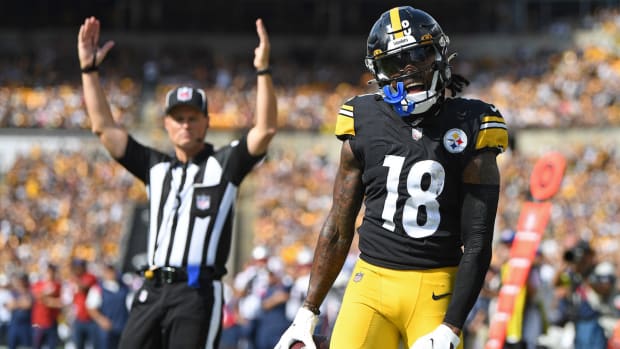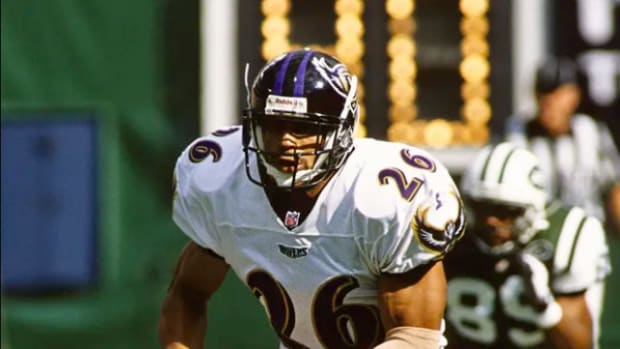A Love Letter to Baker Mayfield
Four weeks ago, I emailed my editors asking if I could please, PLEASE write about how I was falling in love with the Panthers offense. They said yes, and so I wrote about 1,000 words saying something to the effect that Carolina’s is as well-constructed as any in football.
But since then, the Panthers have lost four straight, so last weekend I found myself hastily emailing those same editors, inquiring if I could write about my new football crush—a certain rookie quarterback who was drafted No. 1 overall this year. (Awkwardly, Baker Mayfield’s Browns host the Panthers this Sunday... a clash of my current and former crushes.)
Mayfield is not a big, strong pocket passer like Andrew Luck or Carson Wentz, other QBs who have stolen my heart before. And in my campaigning to write about Mayfield, I admitted that this particular football crush feels a little dangerous—like I wouldn’t want my parents knowing about it—and sure enough in the first half against Houston last weekend, Mayfield threw a trio of reckless interceptions. Before the fourth quarter, executive editor Mark Mravic emailed me with instructions to ignore Mayfield and instead write about the Texans’ Super Bowl chances. But here’s the sick part: I pleaded to write the Mayfield love letter anyway. “I don’t care that he lost and had a bunch of bad plays,” I texted Mravic after emailing him the same thing three minutes earlier.
You can’t reason with twitterpated people, and so here I am, writing about my Baker Mayfield crush, the editors having thrown up their hands. Yes, Mayfield’s poor first half at Houston cost Cleveland that game, but those interceptions are just part of a big-picture learning process. There will be days where a rookie QB simply doesn’t read the field well—especially against disguised eight-man zone coverages that derive from false blitz looks, like what Houston was showing Mayfield.
VRENTAS: Why Mike McCarthy and Josh McDaniels Are Still in Demand as NFL Head Coaches
I’m still enchanted by Mayfield, perhaps in part because I’m surprised by his early success. Deep down, I didn’t think his game would translate well to the NFL. And who knows, ultimately it might not, and we won’t really know for at least a few years. But through 10 outings, Mayfield is a lot better than I expected, and what I love most is the unwavering confidence that he showed in the second half at Houston, after his terrible start. I’m not talking about the candor or chip on his shoulder to which outsiders assign an arbitrary meaning and then blow way out of proportion. I’m talking about how Mayfield plays. There is an uncommon decisiveness to the way reads the field and throws the ball. Consequently, his ball travels with great precision and velocity, particularly when attacking the intermediate levels downfield.
First-half debacle against the Texans aside, even more impressive are the throws Mayfield doesn’t make. We think of quarterback decision-making in terms of a passer finding the open guy, but almost as important is a passer’s ability to eliminate the covered guy. This hidden trait—getting off bad reads quickly—is how a quarterback gets to his late progressions on schedule. When you master that art, your checkdowns also gain potency, as you hit them more expeditiously, before a defense’s coverage has unfolded. This is why running backs who play with Tom Brady, Philip Rivers, Ben Roethlisberger or Drew Brees have so many receiving yards. As a field reader, Mayfield is a long ways from those future Hall of Famers, but so far, he’s at least on the right path.
Speaking of Brees, Mayfield, who comes in at just under 6' 1", must model his game after the future NFL Hall-of-Famer. There are cases where Mayfield simply can’t see downfield in the course of a normal dropback, which led to some throws left on the field early in the year. But like Brees has done, Mayfield is learning to offset this with subtle but difficult adjustments to his pocket movement.
WILDER: Baker Mayfield Should Keep Speaking His Mind
The other QB to whom Mayfield is compared, of course, is Russell Wilson, who often compensates for diminutive height by getting outside the pocket. I was skeptical that Mayfield could extend plays in the NFL the way he did at Oklahoma, especially after some of his pre-draft athletic tests were so mediocre. But thus far, Mayfield has. Unlike many young QBs, he doesn’t move for the sake of moving; he gets outside the pocket with purpose. When doing so, he consistently keeps his eyes downfield and maintains a thrower’s posture and mindset. When most young QBs move, they become runners. From there, they either remain runners and take off, or they try to become passers again, which often results in late or inaccurate throws. Mobile pass-first QBs of Mayfield’s ilk are more effective than even the most athletically enthralling mobile quarterbacks.
All of these intriguing Mayfield traits have shown up more since Week 9, when Freddie Kitchens became Cleveland’s offensive coordinator. In Kitchens’s first few outings, the Browns offense was reduced to more traditional pass designs behind a smashmouth ground game. It stabilized, and the offense has since expanded into a more aggressive, comprehensive passing game. If this progress continues, Browns GM John Dorsey may have to consider narrowing his head coaching search to defensive candidates who are willing to keep Kitchens on as the offensive coordinator.
Whoever Dorsey hires, he must be someone who can maximize Mayfield. I don’t want him to break my heart.
Subscribe to The MMQB Podcasts and get more of Andy Benoit’s analysis on The NFL Deep Dive Show every Thursday
TWEET ELABORATION
Bell will run into this problem with other teams, and the fact that so many “low-pedigree” backs like Phillip Lindsay, Matt Breida and Aaron Jones have prospered with their shifty quickness will make more than a few GMs think Bell isn’t worth his asking price. Bell’s free-agency experience will reveal a lot about the state of NFL running backs.
PACKERS’ HEAD COACH SEARCH
Green Bay’s head coaching search will almost certainly be the most interesting of this offseason, if not of this decade. How often does a marquee franchise with a Hall of Fame quarterback look for a new leader? What I’ve heard about Aaron Rodgers from those close to him and from around the league, my sense is the Packers cannot go with a young coach, even if youthful offensive savants—i.e. the next McVay or Nagy—are likely to be all the rage this offseason. That would mean no Lincoln Riley, no Zac Taylor, no John DeFilippo, etc.
JONES: Why Nick Saban Coaching the Packers Isn’t a Crazy Idea
RUNNING THE BALL
DeFilippo’s head coaching prospects look a little dimmer as he’s fallen under so much negative pressure, both external and internal, to run the ball more. But let's not get carried away here. Almost every well-known offensive play-caller in history has been criticized at some point for not running the ball, but the gripe has different connotation in today’s game. The NFL is now a passing league, though it’s not necessarily a more offensively aggressive league. The uptick in passes come mainly from the uptick in wide receiver screens, quick throws on called run plays (aka “smoke”) and RPOs. If you view these throws as an extension of the running game, it’s harder to criticize a play-caller for being unbalanced. This isn’t to say DeFilippo shouldn’t indeed run the ball more, it’s just a reminder that those situations are less black and white than they appear.
KANSAS CITY POST-KAREEM HUNT
The Chiefs will be fine without Kareem Hunt. In 2016, Spencer Ware rushed for 921 yards and, just as importantly, had 447 yards receiving. The incorporation of the running back into the passing game is a big part of Andy Reid’s offense—it’s not just that Reid throws to the back, it’s that he also sends him on vertical routes. Running backs rarely do that; when starting from deep in the backfield, it’s impossible for their vertical routes to get very vertical, so coaches say forget it. But Reid understands that if other offenses say forget it, then defenses don’t usually have a plan for it. Reid took these ideas to another level in 2016, with Ware often being the unexpected vertical receiver.
NON-FOOTBALL THING ON MY MIND
Few things are as awful as sitting in a quiet restaurant with copious empty tables and having other patrons seated at a table near you. On self-seating, it’s rude to crowd someone’s table like this. The same rules that apply on a subway or at the urinals should apply here: when possible, choose a spot that’s relatively distant from other people. At restaurants where guests are seated by the hostess, it’s just selfish restaurant management. The restaurant wants to look lively, not empty, so its hosts and hostesses plop everyone near each other, hoping for the illusion of vibrancy. The problem is, in an uncrowded restaurant, you can distinctly hear the conversations of people nearby, which means they can also hear yours. Because of this, nothing good is heard or said. New Yorkers should feel especially strongly about our nation’s seating distribution problem given their city’s unofficial ordinance that all restaurant tables be no more than three inches apart from one another.
Question or comment? Email us at talkback@themmqb.com.




































